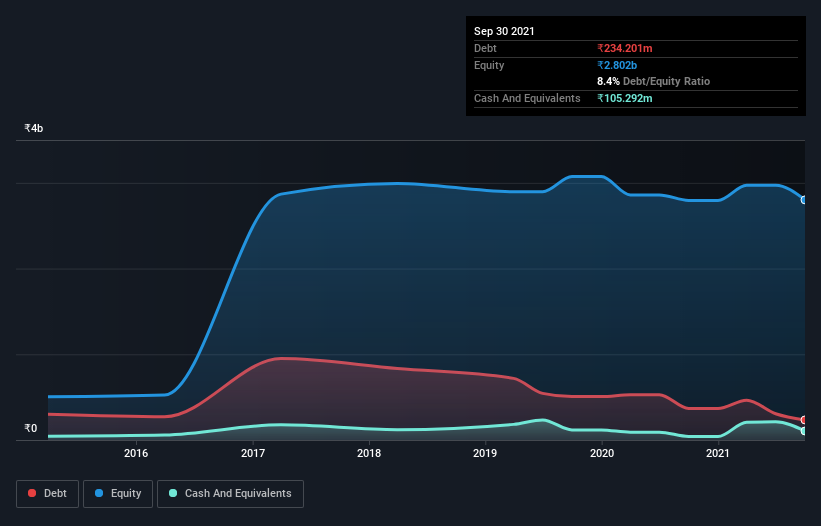We Think Windsor Machines (NSE:WINDMACHIN) Can Stay On Top Of Its Debt
Some say volatility, rather than debt, is the best way to think about risk as an investor, but Warren Buffett famously said that 'Volatility is far from synonymous with risk.' So it seems the smart money knows that debt - which is usually involved in bankruptcies - is a very important factor, when you assess how risky a company is. We can see that Windsor Machines Limited (NSE:WINDMACHIN) does use debt in its business. But is this debt a concern to shareholders?
Why Does Debt Bring Risk?
Debt and other liabilities become risky for a business when it cannot easily fulfill those obligations, either with free cash flow or by raising capital at an attractive price. Ultimately, if the company can't fulfill its legal obligations to repay debt, shareholders could walk away with nothing. However, a more usual (but still expensive) situation is where a company must dilute shareholders at a cheap share price simply to get debt under control. Of course, plenty of companies use debt to fund growth, without any negative consequences. When we examine debt levels, we first consider both cash and debt levels, together.
View our latest analysis for Windsor Machines
What Is Windsor Machines's Debt?
The image below, which you can click on for greater detail, shows that Windsor Machines had debt of ₹234.2m at the end of September 2021, a reduction from ₹367.8m over a year. However, it does have ₹105.3m in cash offsetting this, leading to net debt of about ₹128.9m.

How Healthy Is Windsor Machines' Balance Sheet?
Zooming in on the latest balance sheet data, we can see that Windsor Machines had liabilities of ₹2.06b due within 12 months and liabilities of ₹923.8m due beyond that. Offsetting this, it had ₹105.3m in cash and ₹256.9m in receivables that were due within 12 months. So its liabilities outweigh the sum of its cash and (near-term) receivables by ₹2.62b.
This is a mountain of leverage relative to its market capitalization of ₹3.10b. This suggests shareholders would be heavily diluted if the company needed to shore up its balance sheet in a hurry.
We use two main ratios to inform us about debt levels relative to earnings. The first is net debt divided by earnings before interest, tax, depreciation, and amortization (EBITDA), while the second is how many times its earnings before interest and tax (EBIT) covers its interest expense (or its interest cover, for short). The advantage of this approach is that we take into account both the absolute quantum of debt (with net debt to EBITDA) and the actual interest expenses associated with that debt (with its interest cover ratio).
Windsor Machines has a very low debt to EBITDA ratio of 0.47 so it is strange to see weak interest coverage, with last year's EBIT being only 2.3 times the interest expense. So one way or the other, it's clear the debt levels are not trivial. Notably, Windsor Machines made a loss at the EBIT level, last year, but improved that to positive EBIT of ₹143m in the last twelve months. The balance sheet is clearly the area to focus on when you are analysing debt. But it is Windsor Machines's earnings that will influence how the balance sheet holds up in the future. So if you're keen to discover more about its earnings, it might be worth checking out this graph of its long term earnings trend.
Finally, a business needs free cash flow to pay off debt; accounting profits just don't cut it. So it's worth checking how much of the earnings before interest and tax (EBIT) is backed by free cash flow. Over the last year, Windsor Machines actually produced more free cash flow than EBIT. That sort of strong cash conversion gets us as excited as the crowd when the beat drops at a Daft Punk concert.
Our View
Windsor Machines's conversion of EBIT to free cash flow was a real positive on this analysis, as was its net debt to EBITDA. But truth be told its interest cover had us nibbling our nails. Looking at all this data makes us feel a little cautious about Windsor Machines's debt levels. While debt does have its upside in higher potential returns, we think shareholders should definitely consider how debt levels might make the stock more risky. The balance sheet is clearly the area to focus on when you are analysing debt. However, not all investment risk resides within the balance sheet - far from it. We've identified 3 warning signs with Windsor Machines , and understanding them should be part of your investment process.
Of course, if you're the type of investor who prefers buying stocks without the burden of debt, then don't hesitate to discover our exclusive list of net cash growth stocks, today.
Valuation is complex, but we're here to simplify it.
Discover if Windsor Machines might be undervalued or overvalued with our detailed analysis, featuring fair value estimates, potential risks, dividends, insider trades, and its financial condition.
Access Free AnalysisHave feedback on this article? Concerned about the content? Get in touch with us directly. Alternatively, email editorial-team (at) simplywallst.com.
This article by Simply Wall St is general in nature. We provide commentary based on historical data and analyst forecasts only using an unbiased methodology and our articles are not intended to be financial advice. It does not constitute a recommendation to buy or sell any stock, and does not take account of your objectives, or your financial situation. We aim to bring you long-term focused analysis driven by fundamental data. Note that our analysis may not factor in the latest price-sensitive company announcements or qualitative material. Simply Wall St has no position in any stocks mentioned.
About NSEI:WINDMACHIN
Windsor Machines
Engages in the manufacture and sale of plastic processing machinery in India and internationally.
Adequate balance sheet with questionable track record.
Similar Companies
Market Insights
Community Narratives



